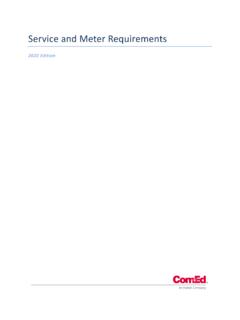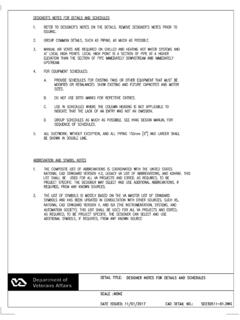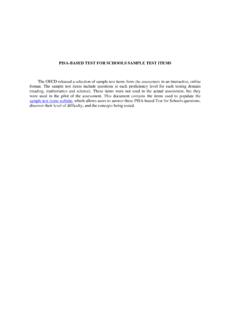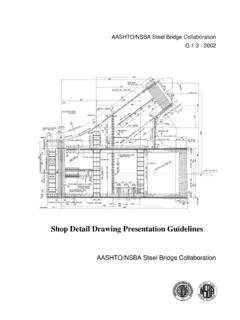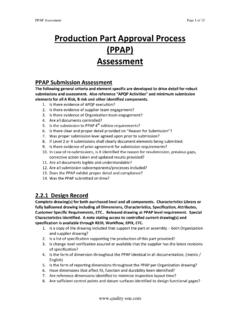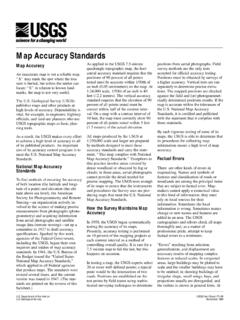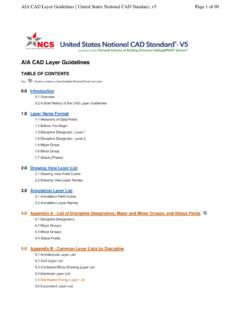Transcription of approved meter connection devices - ComEd
1 ComEd An Exelon Company CATALOG OF meter connection devices approved BY meter ENGINEERING AND STANDARDS Revised: December 2015
2 approved meter connection devices TABLE OF CONTENTS Page Information & Requirements for meter connection devices 1 - 5 approved meter connection devices Anchor 6 Briggs and Stratton 6
3 Milbank 16 - 17 Thomas and Betts Cutler Hammer 7-8 Durham 9 Electrical Products Corp. (EPC) 10 Erickson 11 General Electric Co. 12 Landis & Gyr 13 meter devices Company 14 Midwest Electrical Products 15 Murray Electrical Products 18 Siemens 19 Square D Company 20 Switchboard Apparatus Co.
4 21 Talon 22 23 Cross Reference List of Transformer Rated meter Conn. devices 24 approved Current Transformer Compartments 25 - 26 List of Manufacturers and Local Representatives 27 - 30 Revised: December 2015 approved meter connection devices INFORMATION & REQUIREMENTS FOR meter CONNNECTION devices I.
5 BASIC REQUIREMENTS With regard to meter connection devices that are approved for use in the ComEd service area, the basic requirements are as follows: 1) All meter connection devices must have CECHA stamp. 2) All meter connection devices must have ringless covers and reinforced jaws 3) By-passes are required on all meter sockets (horn type on single-phase and lever arm type on polyphase. The above requirements are listed on each of the manufacturers pages in this catalog to further emphasize their importance. II. TYPICAL meter connection devices The arrangement of meter connection devices will generally fall into one of the following categories: 1) Single position overhead 2) Single position underground (with raceway) 3) Multiple position horizontal grouped sockets (overhead or underground service) 4) All-In-One type multiple position metering unit (overhead or underground service) 5) Vertically grouped sockets (multiple position; indoor or outdoor) 6) Switchboard type metering panels (multiple position.
6 Indoor) Diagrams of these various categories are shown in Exhibit A. Categories 1 through 4 above will generally be installed outdoors. The vertically grouped sockets (category 5) can be installed indoors or outdoors. The installation of vertical sockets will be covered in greater detail in Section V. Category 6 (switchboard type metering panels) are designed for indoor installation, mainly in commercial buildings. III. meter MOUNTING HEIGHTS meter connection devices must be installed at heights where meters can be installed and read safely by meter personnel standing adjacent to the meter .
7 Access to meters by crawling on hands and knees or by standing on a ladder is not acceptable. The minimum meter mounting height is 30-inches, and the maximum height can be 60 to 72 inches depending on the type of meter connection device. The minimum and maximum meter mounting heights are shown in Exhibit A. Revised: December -2015 1 approved meter connection devices INFORMATION & REQUIREMENTS (Continued) IV.
8 RACEWAY REQUIREMENTS FOR UNDERGROUND SERVICE Wherever an underground service is to be connected to a meter connection device, a raceway must be used to route the cables to the terminals within the device. This is evident in all the single position underground devices that are currently CECHA listed,as they are all designed as a combination meter socket and raceway. This is true of both single-phase and polyphase units. With regard to the multi-position units such as the All-In-One type or the horizontal grouped sockets as shown in Exhibits A and B, a raceway is required on all underground service connections to these units.
9 These raceways are available from some socket manufacturers and local switchboard builders. V. REQUIREMENTS ASSOCIATED WITH VERTICALLY GROUPED MODULES Vertically grouped meter connection devices ( meter modules) are generally available in 2, 3 or 4 positions and they can be bussed together to provide multiple meter points at a single location. An example of where these meter modules would be used is in a multi-story building in meter rooms on the various floors of the building. These meter modules are always installed with some type of main device which can be a termination box, fused switch or circuit breaker.
10 The electric service supply will terminate in this main device, and the meter modules will be internally connected to this main device by buss bars. The main device can be connected directly to the adjacent meter modules if both units have the same front to rear dimension (or depth). However, if the main device has a greater depth than the adjacent meter modules, a spacer is required between the two units. Exhibit C outlines the conditions where a spacer is required. In the majority of these types of installations utilizing vertical meter modules, a spacer will be required between the main device and adjacent meter modules.





